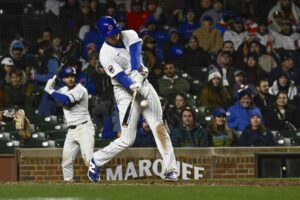Arizona Diamondbacks Pitchers Haunted by Walks
It goes without saying that the Arizona Diamondbacks did not like their Opening Weekend performance against the San Diego Padres. They were outscored 21-9 while batting .195. Their ERA of 5.73 is dead last in the National League. Only one starting pitcher – Madison Bumgarner – pitched more than four innings, and he did not make it through the sixth. One concern supersedes all of these, though – walks. In 33 innings, they walked 27 Padres.
The Padres had 28 hits in the series. This is higher than the Diamondbacks would have liked, of course, but 28 hits allowed in a season-opening four-game series is something they could live with. The walks were a different story. Walking 27 in 33 innings translates to 7.4 walks per nine. Manager Torey Lovullo said that an acceptable number is two or three.
Some may claim that the Diamondbacks pitchers gave up too many hits, but that isn’t the case. Had the walks been on the high end of what Lovullo said is acceptable, that would have translated to 11 walks in the series. Combining that with the 28 hits would have made the WHIP 1.182. The league average WHIP over the past decade has hovered around 1.300 every season. A WHIP in the 1.200s will get a pitcher onto an All-Star team; a career WHIP in the 1.100s or lower will get him into the Hall of Fame.
The Dangers of So Many Walks
The easy answer to why a high number of walks is bad is that it gives free baserunners to the opponent. But there’s more to it. For one, it runs up pitch counts, getting starting pitchers out of the game faster. When looking at a team’s pitching staff, their best seven pitchers tend to be their starting five, their set-up man, and their closer. When the starter leaves in the fourth, fifth, or sixth inning, opponents often end up facing the eighth-, ninth-, or 10th-best pitcher on the staff. This is not a formula for success if done repeatedly.
Secondly, a high amount of walks often gets hitters into more favorable counts. Take 2019, for example. According to the league-wide splits on Baseball Reference, the collective batting average for all of Major League Baseball was .252 with a .323 on-base percentage (OBP). On a 3-0 count, that jumped to a batting average of .410 and an OBP of .937. Hitters weren’t quite as successful on 3-1 counts, but they still did plenty of damage, batting .363 with a .711 OBP. On full counts, the batting average plummeted to .202, but the OBP was still quite high at .453.
Diamondbacks Walks in San Diego
During the four-game set in San Diego, Diamondbacks pitchers faced 149 hitters. They reached three-ball counts (3-0, 3-1, or 3-2) 55 times, meaning they did so over a third of the time. Bumgarner faced 23 hitters; six saw a three-ball count. Robbie Ray faced 18; 10 reached a three-ball count. Zac Gallen faced 19 and reached a three-ball count with nine of them. Luke Weaver fared best of the four starters in this regard – only four of the 20 hitters he faced saw a three-ball count.
To say that the Diamondbacks pitchers were displeased with their performances is an understatement. Pitching coach Matt Herges told the press Tuesday afternoon via Zoom, “No one in that clubhouse is happy with how they’ve pitched except Taylor Clarke,” who threw 3 2/3 innings of no-hit, shutout ball in relief during Monday’s game. Herges told the press that the main reason for all the walks and three-ball counts is that the pitchers “aren’t attacking (the zone) enough.” As for why, there could be one or two factors at play. The pitchers possibly are “trying to be too fine.” They also possibly “aren’t giving enough credit to the hitter,” in reference to plate discipline. It could be both.
How to Turn It Around
Herges is reminding the staff that the “best pitchers in the league throw a high percentage of strikes.” The pitchers need to have the mindset of “attack (the zone) and not worry about swings.” He is encouraging them to throw strikes because they “have good stuff.” Their pitches – even when facing professionals – are tough to hit when they’re in the zone. Lovullo said later that he’s encouraging the pitchers to throw it in the zone and “trust the eight guys playing behind (them).” Herges said he’s put it another way when talking to the pitchers, “Guys, your stuff plays (in the zone). It’s legit.”
Main Photo
Embed from Getty Images






